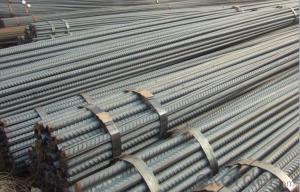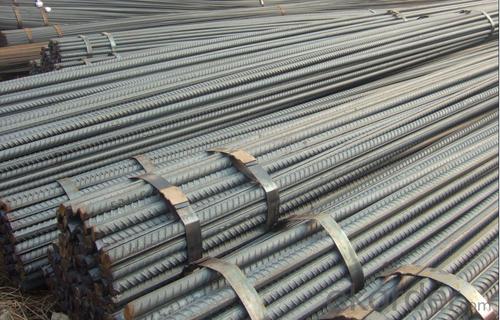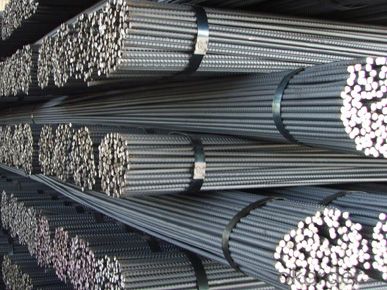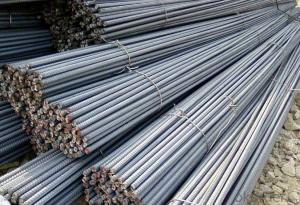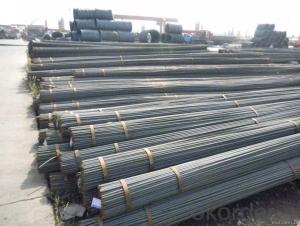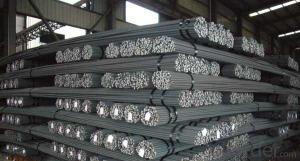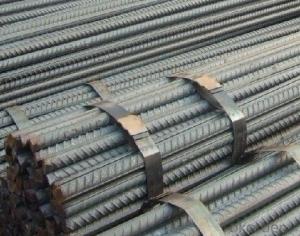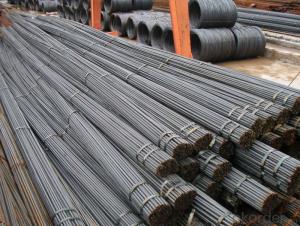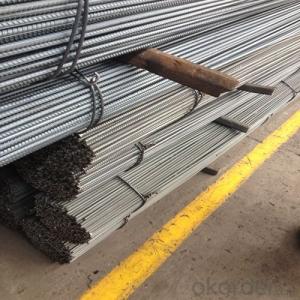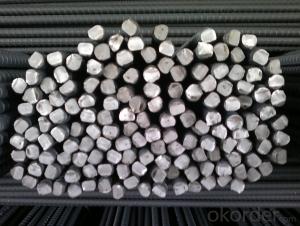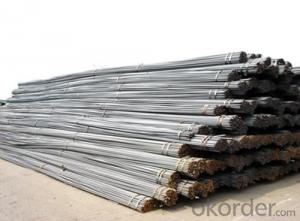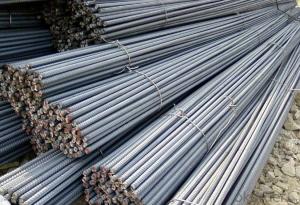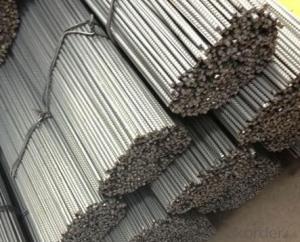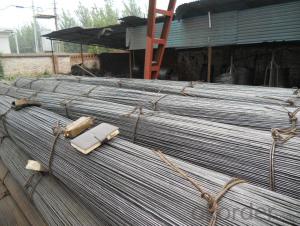Deformed Steel Rebar Straight High Quality
- Loading Port:
- China main port
- Payment Terms:
- TT OR LC
- Min Order Qty:
- 25 m.t.
- Supply Capability:
- 10000 m.t./month
OKorder Service Pledge
OKorder Financial Service
You Might Also Like
Specifications
Standard | GB | HRB400 | |
Diameter | 6mm,8mm,10mm,12mm,14mm,16mm,18mm,20mm, 22mm,25mm,28mm,32mm,36mm,40mm,50mm | ||
Length | 6M, 9M,12M or as required | ||
Place of origin | Hebei, China mainland | ||
Advantages | exact size, regular package, chemical and mechanical properties are stable. | ||
Type | Hot rolled deformed steel bar | ||
Chemical Composition: (Please kindly find our chemistry of our material based on HRB500 as below for your information)
Grade | Technical data of the original chemical composition (%) | ||||||
C | Mn | Si | S | P | V | ||
HRB400 | ≤0.25 | ≤1.60 | ≤0.80 | ≤0.045 | ≤0.045 | 0.04-0.12 | |
Physical capability | |||||||
Yield Strength (N/cm²) | Tensile Strength (N/cm²) | Elongation (%) | |||||
≥400 | ≥570 | ≥14 | |||||
Usage and Applications
Deformed bar is widely used in buildings, bridges, roads and other engineering construction. Big to highways, railways, bridges, culverts, tunnels, public facilities such as flood control, dam, small to housing construction, beam, column, wall and the foundation of the plate, deformed bar is an integral structure material. With the development of world economy and the vigorous development of infrastructure construction, real estate, the demand for deformed bar will be larger and larger..
Packaging & Delivery
Packaging Detail: products are packed in bundle and then shipped by container or bulk vessel, deformed bar is usually naked strapping delivery, when storing, please pay attention to moisture proof. The performance of rust will produce adverse effect.
Each bundle weight: 2-3MT, or as required
Payment term: TT or L/C
Delivery Detail: within 45 days after received advanced payment or LC.
Label: to be specified by customer, generally, each bundle has 1-2 labels
Trade terms: FOB, CFR, CIF
Note
1. Our products are produced according to national standard (GB), if not, supply according to national standards (GB) or agreement as customer required.
2. Other Grade and Standard Deformed Steel Bar we can supply:
Grade: GR40/GR60, G460B/B500A/B500B/B500C,BST500S
Standard: ASTM, BS, DIN
The Minimum Order Quantity of these products is high, and need to be confirmed.
3. We can not only supply Deformed Steel Bar; if you need anything about building materials, please contact us for further information.
4. Please send us your detail specifications when inquire. We will reply to you as soon as possible. We sincerely hope we can establish a long stable business relationship.
- Q: How do steel rebars contribute to the durability of a structure?
- Steel rebars contribute to the durability of a structure by providing reinforcement and strength to concrete. They help to prevent cracking and structural failure by absorbing and distributing tensile forces, enhancing the overall structural integrity and resilience. Additionally, steel rebars offer resistance to corrosion, ensuring the longevity and durability of the structure.
- Q: What is the corrosion resistance of steel rebars?
- The surface of steel rebars forms a protective layer, known as a passive film, which provides excellent corrosion resistance. This film is created when the steel interacts with the surrounding environment. By acting as a barrier, the passive film prevents oxygen and moisture from reaching the steel, thus inhibiting corrosion. There are various factors that contribute to the corrosion resistance of steel rebars. For example, the presence of alloying elements like chromium, nickel, and molybdenum improves the formation and stability of the passive film, making the rebars more resistant to corrosion. Additionally, the composition and microstructure of the steel rebars play a crucial role in determining their resistance to corrosion. However, it is important to note that the corrosion resistance of steel rebars can be compromised under certain conditions. High levels of chlorides, such as those in marine environments or de-icing salts, can accelerate corrosion and reduce the effectiveness of the passive film. Similarly, exposure to acidic or alkaline environments can also negatively affect the corrosion resistance of steel rebars. To minimize the risk of corrosion, various protective measures can be taken. These include applying coatings or paints to the rebars, using corrosion inhibitors, or implementing cathodic protection systems. Regular inspection, maintenance, and proper design and construction practices are also essential to ensure the long-term corrosion resistance of steel rebars in different applications. In conclusion, the excellent corrosion resistance of steel rebars is due to the formation of a protective passive film. However, this resistance can be influenced by factors such as the environment, alloying elements, and microstructure. By implementing appropriate protective measures and maintenance practices, the corrosion resistance of steel rebars can be effectively maintained, ensuring their durability and structural integrity.
- Q: Can steel rebars be used in the construction of offshore oil platforms?
- Yes, steel rebars can be used in the construction of offshore oil platforms. Steel rebars are commonly used in construction to reinforce concrete structures and provide additional strength and durability. In the case of offshore oil platforms, steel rebars are used to reinforce the concrete foundations and structures of the platform, helping to withstand the harsh environmental conditions and the weight of the equipment and infrastructure on the platform. The steel rebars are designed to resist corrosion and are typically coated with epoxy or other protective coatings to prevent rusting in the corrosive marine environment. Additionally, steel rebars can be custom-designed to meet the specific requirements of the offshore oil platform, ensuring they provide the necessary strength and stability.
- Q: What are the guidelines for the proper lap splicing of steel rebars?
- The guidelines for the proper lap splicing of steel rebars are as follows: 1. Lap Length: The lap length refers to the minimum distance required for the overlapping of rebars. It is determined based on factors such as bar diameter, strength, and the type of structure. Generally, lap lengths are specified by engineering codes and standards. 2. Cleanliness: Before proceeding with lap splicing, it is essential to ensure that the rebars are free from any dirt, rust, oil, or other contaminants. Any foreign material on the rebar surface can hinder the bond between the overlapping bars. 3. Alignment: The rebars to be spliced must be properly aligned and parallel to each other. Any misalignment can result in a weak splice and compromise the structural integrity of the construction. 4. Overlapping: The overlapping length of rebars should be sufficient to ensure the transfer of loads and maintain the continuity of reinforcement. It is crucial to follow the specified lap length to achieve the required strength and performance of the reinforced concrete structure. 5. Splice Configuration: The type of lap splice configuration depends on the structural requirements and the specific design of the project. Commonly used splice configurations include end-to-end splicing, staggered splicing, and mechanical splices. The selection of the appropriate splice configuration should be in compliance with relevant codes and standards. 6. Splice Preparation: The rebars at the lap splice area should be properly cleaned and prepared. This involves removing any loose rust or scale from the bar surface and providing adequate bond length between the bars. 7. Lap Splice Placement: The lap splice should be positioned at the designated location within the concrete member. It is important to ensure that the splice is not too close to the edge of the concrete element, as this can reduce the cover depth and affect the durability of the structure. 8. Splice Length Variations: In cases where the required lap length is not achievable due to space limitations or other restrictions, approved alternatives such as mechanical splices or welded splices can be considered. However, it is essential to consult the project engineer or designer to ensure compliance with the appropriate guidelines. 9. Quality Control: Proper quality control measures should be implemented during the lap splicing process. This includes monitoring the lap splice length, ensuring proper alignment, and conducting periodic inspections to check for any defects or deficiencies. It is important to note that the above guidelines are general recommendations, and the specific requirements for lap splicing may vary depending on the design specifications, construction codes, and local regulations. Therefore, it is always advisable to consult the project engineer or designer for the precise guidelines applicable to a particular project.
- Q: What are the weight and density of steel rebars?
- Steel rebars, also known as reinforcing bars, are commonly utilized in construction to impart tensile strength to concrete structures. The weight and density of steel rebars may differ depending on their size and grade. The weight of a steel rebar is determined by its cross-sectional area and the specific weight of steel, which is roughly 7850 kilograms per cubic meter (or 0.2836 pounds per cubic inch). The cross-sectional area is usually quantified in square millimeters or square inches. For instance, a prevalent size of steel rebar is the #4 bar, possessing a diameter of 12.7 millimeters (or 0.5 inches) and a cross-sectional area of 127 square millimeters (or 0.197 square inches). By employing the specific weight of steel, we can compute the weight of a #4 rebar in the following way: Weight = Cross-sectional area x Specific weight of steel Weight = 127 mm^2 x 7850 kg/m^3 Weight = 998,950 grams or approximately 998.95 kilograms (or 2,201 pounds) Concerning density, the density of steel rebars coincides with the specific weight of steel, which is roughly 7850 kilograms per cubic meter. This density remains relatively consistent across diverse sizes and grades of steel rebars. It is important to acknowledge that the weight and density of steel rebars may slightly fluctuate based on the precise composition and manufacturing process. It is therefore prudent to refer to the manufacturer's specifications or consult engineering references for precise and up-to-date information.
- Q: What are the different types of steel rebars used in dam constructions?
- In dam constructions, different types of steel rebars are utilized, each possessing specific properties and applications. The commonly employed variants consist of: 1. Mild Steel Rebars, which are manufactured using low carbon steel. Due to their affordability and availability, they find extensive use in dam constructions. Although they exhibit good tensile strength, their resistance to corrosion is relatively low. 2. High Strength Deformed (HSD) Steel Rebars, on the other hand, are crafted from carbon steel and incorporate additional alloys like vanadium or manganese. These rebars offer heightened tensile strength and superior corrosion resistance when compared to their mild steel counterparts. They are typically employed in critical areas of the dam structure that demand enhanced strength. 3. Epoxy-Coated Rebars, as the name suggests, involve the application of an epoxy coating to enhance their resistance to corrosion. This protective layer acts as a barrier against moisture and chemicals, thereby minimizing the risk of corrosion. Epoxy-coated rebars are frequently employed in dam constructions that anticipate exposure to harsh environmental conditions. 4. Stainless Steel Rebars are characterized by their remarkable resistance to corrosion and are typically used in dam constructions that involve aggressive environments such as saltwater or chemical-laden water. Although they are more expensive than other types of rebars, they offer unparalleled durability. 5. Galvanized Rebars, which are coated with a layer of zinc, exhibit excellent corrosion resistance. They are commonly employed in dam constructions where the structure will encounter water or moisture for extended periods. The selection of the most suitable type of steel rebar for dam construction is contingent upon various factors, including the specific project requirements, anticipated environmental conditions, and budgetary constraints. An engineering team will meticulously assess these factors in order to determine the optimal type of steel rebar that ensures the longevity and structural integrity of the dam.
- Q: Can steel rebars be used in structures with high moisture content?
- Steel rebars can be used in structures with high moisture content, but proper precautions should be taken to prevent corrosion. Moisture can accelerate the corrosion process of steel, which can weaken the rebars and compromise the structural integrity of the building. To mitigate this risk, measures such as using corrosion-resistant coatings, proper waterproofing, and regular maintenance should be implemented to protect the rebars and ensure the safety and longevity of the structure.
- Q: What are the advantages of using steel rebars in construction?
- Steel rebars offer several advantages in construction. Firstly, they provide strength and durability to reinforced concrete structures, making them capable of withstanding heavy loads and extreme weather conditions. Secondly, steel rebars have excellent tensile strength, allowing them to absorb and distribute stress more effectively, preventing concrete from cracking or breaking under tension. Additionally, steel rebars can be easily fabricated and shaped to fit specific project requirements, providing flexibility in design. They also offer corrosion resistance, ensuring the longevity and integrity of the structure. Overall, the use of steel rebars enhances the structural integrity, safety, and longevity of construction projects.
- Q: How are steel rebars used in flat slabs and beams?
- Steel rebars are used in flat slabs and beams to provide reinforcement and increase the structural strength of the concrete. They are placed strategically within the slabs and beams to resist tensile forces and prevent cracking or failure under heavy loads. The rebars act as a framework that enhances the overall durability and load-carrying capacity of the flat slabs and beams, ensuring their stability and longevity.
- Q: What is the effect of overloading on steel rebars?
- Overloading on steel rebars can have a detrimental effect on their structural integrity. It can lead to deformation, bending, or even fracture of the rebars, compromising the overall strength and stability of the reinforced structure. Additionally, overloading can accelerate corrosion processes, reducing the rebars' lifespan and potentially causing structural failure. Therefore, it is essential to ensure that steel rebars are not subjected to excessive loads to maintain their performance and prevent potential hazards.
Send your message to us
Deformed Steel Rebar Straight High Quality
- Loading Port:
- China main port
- Payment Terms:
- TT OR LC
- Min Order Qty:
- 25 m.t.
- Supply Capability:
- 10000 m.t./month
OKorder Service Pledge
OKorder Financial Service
Similar products
Hot products
Hot Searches
Related keywords
